
Tokyo DisneySea opened in 2001 as the second park of the rebranded Tokyo Disney Resort. A few months earlier, the original Disneyland Resort in California had received a second park in the form of Disney’s California Adventure, drawing inevitable comparison. DisneySea, however, was built with nearly four times the budget of its Californian sister, earning the prestigious title of the world’s most expensive theme park at over US $4 billion and making California Adventure all the more embarrassing.
Of course, that was possible because The Walt Disney Company had nothing to do with the budget at Tokyo DisneySea – the park, like Tokyo Disneyland, is entirely owned by the Oriental Land Company. Disney sends Imagineers to Tokyo, and the Oriental Land Company funds their ideas with apparently little to no budget constraint, preferring to create what some call the best theme park in the world.
Like Disneyland, DisneySea is divided into separately themed lands (here called “ports”) that all focus on the power, mystery, and exploration of water and the way it’s created societies around the globe. Like California Adventure compared to Disneyland, DisneySea is undeniably more “adult” than the castle park next door. Its settings, stories, and characters are much more based in reality; more gritty; more mysterious. On the monorail, many families disembark at Disneyland Park while groups of school age children (impossibly well-behaved, reverent, and respectful, I should add) stay on toward DisneySea Station.
And indeed, one of the subtle things that sets DisneySea apart is its tasteful lack of Disney characters. Most of the stories, characters, and settings in the park are original or adapted from literature rather than films. Where Disney characters do make an appearance, it’s understated, appropriate, and doesn’t detract from the story to be told. For example, walking through the Arabian Coast, you pass through a marketplace complete with a (well-designed and totally unassuming) Skee-ball carnival game with stuffed animal prizes. Above the game, one notices that an animatronic Abu has one of the prizes in hand and is swinging back and forth from his tail as he steals it. In that same port, a small tile mosaic of Jasmine is placed above a small spitting fountain in a back alley – appropriate given that this desert city may well be Agrabah or under its reign.
With that in mind, step into DisneySea.
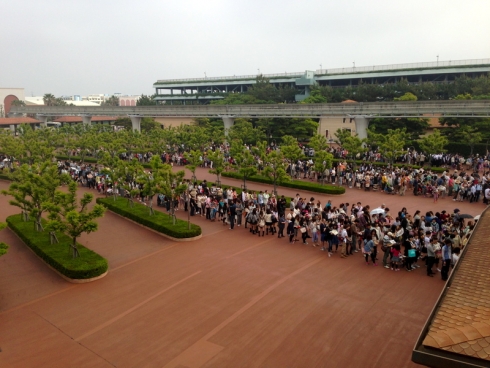
Entering through the turnstiles, you first see the Aquasphere, an imposing and yet calming sort of icon for the park. The Aquasphere is a massive, slowly revolving sculpture of earth with water slowly trickling from the North Pole down the oceans. A huge geyser of water appears to keep the planet afloat, while waves crash and geysers erupt intermittently in the pool at its base.
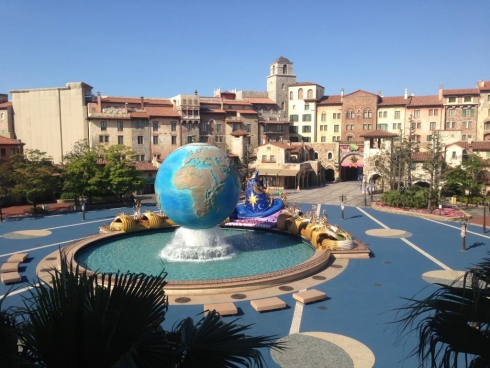
Encircling the Aquasphere are the tall, palatial buildings of an Italian city (a mixture of Venice, Florence, and Rome in terms of architectural style). The sprawling town is made of different buildings scattered about with the golden dome of the Duomo visible in the distance. This city wrapping around the plaza is Hotel Miracosta, one of the most elaborate, impressive, and elegant hotels Disney has ever had its name on. On par with the Grand Floridian or Grand Californian in terms of price, Hotel Miracosta is a wonder. The dome of the Duomo that’s ever visible in the distance is actually the hotel’s lobby. The inside of that dome features incredible murals depicting each of the park’s “ports” and the spirit that correlates.
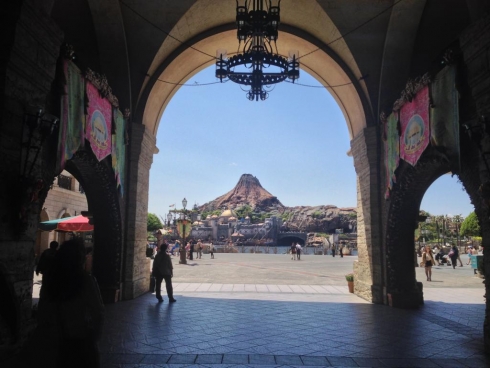 Walking away from the AquaSphere and under the Hotel Miracosta provides your first view of DisneySea.
Walking away from the AquaSphere and under the Hotel Miracosta provides your first view of DisneySea.
A tunnel under the MiraCosta leads from Aquasphere Plaza to the park’s first port.
Mediterranean Harbor
Essentially DisneySea’s “Main Street,” Mediterranean Harbor encircles the massive eponymous lagoon that serves as the park’s main showplace (Water pageants happen here during the day, and Fantasmic! at night). The Hotel Miracosta, of course, is the backdrop of the city, with its expansive buildings hugging the water’s edge where various sailboats, gondolas, and steamers criss-cross the waterway. A seldom-visited back alley leads deeper into the city between wings of the hotel, where a Venetian-style gondola ride is a favorite of couples with more than a few weddings performed on them during my visit alone.
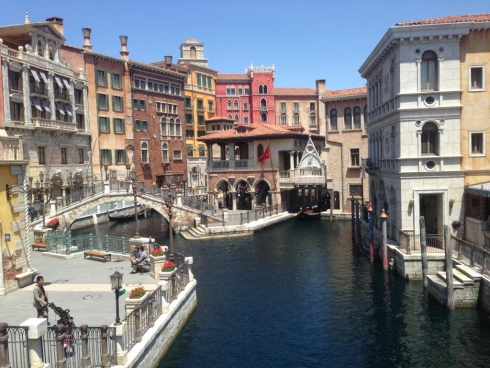 A back alley represents Venice, with the Hotel Miracosta following the flowing channel.
A back alley represents Venice, with the Hotel Miracosta following the flowing channel.
Across the water from the entrance tunnel is the park’s icon, Mount Prometheus. This 180 foot tall volcano indeed smokes, steams, rumbles, and shoots fire all day and night (causing me to briefly compare it to California Adventure’s original “Sun Icon” and ponder which is more emotional and grand).
Mount Prometheus is actually part of another port (the same way that Cinderella Castle is not part of Main Street) but at the mountain's base is Fortress Explorations, a massive Renaissance-era fort half-encased in the volcano’s cooled lava flows. The fort is comprised of four floors connected by spiral staircases and bridges, towers, rooms to explore, and a full-sized sailing ship.
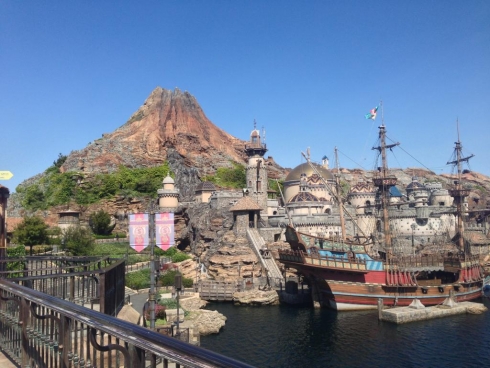 Fortress Explorations and the Renaissance ship are at the base of Mt. Prometheus, encased in cooled lava flows.
Fortress Explorations and the Renaissance ship are at the base of Mt. Prometheus, encased in cooled lava flows.
Fortress Explorations alone could consume a day, as its turrets and domes each contain exhibits like a full-sized planetarium, Da Vinci’s famous Flying Machine, a pendulum, cannons that fire smoke, and a volcano monitoring center. A Japanese-language only adventure game called Leonardo’s Challenge takes place in the fortress, where guests are given a device that interacts with the exhibits if they align planets, release steam pressure from a volcanic chamber, etc.
American Waterfront
First thing in the morning, it’s American Waterfront that gets bombarded by guests after the rope-drop sprint, and it’s easy to see why. The port is divided into three sections: The Big City, Toyville Trolley Park, and Cape Cod.
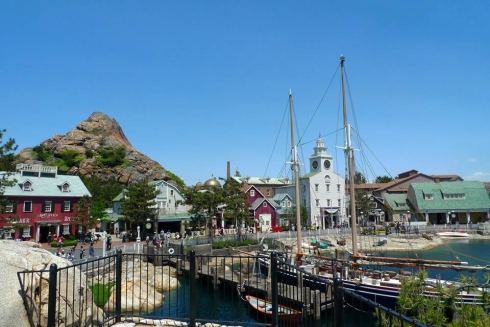 The quiet and calm Cape Cod is built around a small fishing lake. Notice Mt. Prometheus, when viewed from Cape Cod, is designed to look like a Northeastern mountain instead of a mysterious volcano.
The quiet and calm Cape Cod is built around a small fishing lake. Notice Mt. Prometheus, when viewed from Cape Cod, is designed to look like a Northeastern mountain instead of a mysterious volcano.
Cape Cod looks like a small fishing village in the American Northeast, with a tiny inlet harbor of fishing ships and quaint homes on the shore. This area has been entirely dedicated to Duffy. This none-too-special Teddy bear is absolutely the most popular thing to buy in the parks. Most people (yes, MOST) bring Duffy with them to the parks. Young, old, male, female, it doesn’t matter. Everyone has Duffy, period. Duffy purses, Duffy backpacks, Duffy hats, Duffy shirts. There are hundreds and hundreds of outfits for Duffy (and his girlfriend Shellie May) and dozens of spots around the parks with little stands specifically meant for placing Duffy and taking his picture. Duffy is available in all the stores, but the shops, restaurants, and stages in Cape Cod are specifically set-aside for him. The manic obsession with Duffy makes it obvious why Disney has tried to make him catch on at the American parks to no such luck so far.
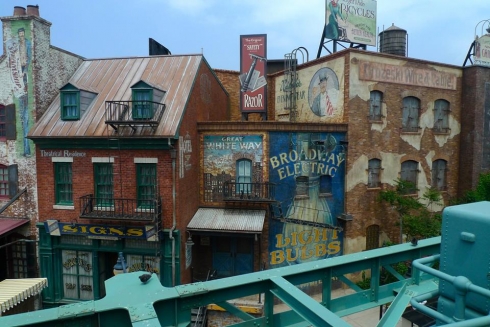 A block of the hyper-detailed "Big City" area as viewed from the elevated electric trolley.
A block of the hyper-detailed "Big City" area as viewed from the elevated electric trolley.
The Big City is themed to New York in the 1920s, with avenues full of dark brick buildings, rooftop billboards, real Red Car Trolleys on elevated electric tracks, delis, diners, and a “Big Band Beat” show in a massive theater about the size of California Adventure’s Hyperion (but still requiring the resort’s “lottery” system to get a seat).
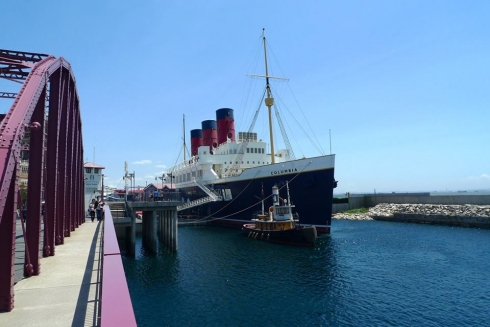 The SS Columbia. The real Tokyo Bay is the expanse of water over the dam on the right. The park is built on the edge of Tokyo Bay.
The SS Columbia. The real Tokyo Bay is the expanse of water over the dam on the right. The park is built on the edge of Tokyo Bay.
A massive, full-sized steamship, the SS Columbia, sits in the water on the edge of the city (with the real Tokyo Bay on the other side). On its bottom floor, it contains Turtle Talk with Crush, while the main upper deck contains a lavish prixe fixe restaurant and the Teddy Roosevelt Lounge, an unimaginable bar and lounge of overstuffed chairs, dark wood, brass, and full bar. In true DisneySea style, you can walk along the decks of the ship all the way to the bow where you can play a nice game of shuffleboard or climb a set of stairs and pull a “Titanic” on the edge of the massive steam liner.
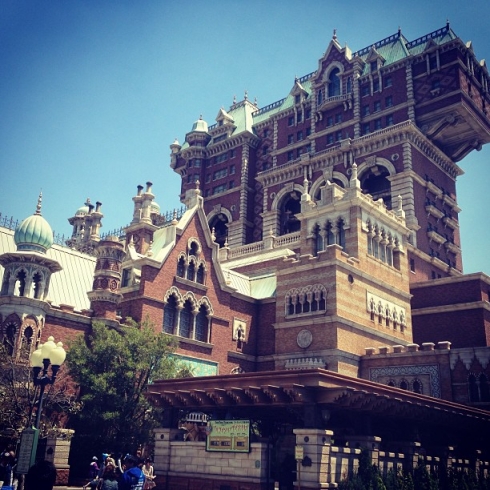 The mysterious Hightower Hotel is the port's centerpiece.
The mysterious Hightower Hotel is the port's centerpiece.
The undeniable center of the area, though, is the Hightower Hotel. According to legend, Mr. Harrison Hightower was a notable and prominent member of the Society of Explorers and Adventurers (S.E.A.) who traveled the world “collecting” ancient artifacts from civilizations around the globe. Indeed, the lobby of the magnificent hotels features murals of Hightower proudly sailing away from a South American tribe with a giant stone lizard head, or racing his hot air balloon (complete with sarcophagus) into the clouds as Egyptians shout from below.
The way the story goes, Mr. Hightower’s most prized possession was a wooden figure he’d located in Africa, actually given to him by a tribal elder who didn’t mind parting with it. On New Years Eve in 1899, Mr. Hightower threw a lavish ball to show off his new trophy. When a visitor asked if the rumors of Shiriki Utundu’s curse gave him pause, Mr. Hightower demonstrated just how unafraid he was by putting his cigar out on Shiriki’s head. Just before midnight, Hightower boarded an elevator to retreat to his penthouse with the idol in hand. According to the story, a green flash of light shattered all the windows of the hotel and Mr. Hightower’s elevator cable snapped. The hotel was abandoned and closed by order of the city of New York. Investigators found the crashed elevator, but Mr. Hightower’s body was not on board. And Shiriki was standing, unharmed, in his special spot next to Hightower’s desk.
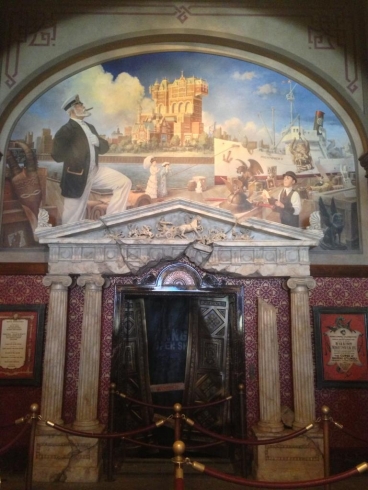 The open elevator shaft, frayed cables, and occasional falling sparks are a departure from Hightower's hubris immortalized above in the hotel's lobby.
The open elevator shaft, frayed cables, and occasional falling sparks are a departure from Hightower's hubris immortalized above in the hotel's lobby.
Of course, it’s more than twenty-five years later now, in 1926 New York, and the old hotel is about to meet the wrecking ball. To save it from destruction, a nonprofit organization had stepped in and is raising money to save the hotel by offering tours of its grounds. Guests are invited to see the garden of corroded statues, step into the once-grand lobby, see the grand vaults containing his treasures, and even visit Mr. Hightower’s office, where Shiriki still remains. Of course, the sensationalized media of the era won’t pick up on a story without a hook, so these tours are being run under the only appropriate name: Tower of Terror.
The line creeps through the hotel grounds and into Mr. Hightower’s office, where a phonograph recording of Hightower’s voice awakens Shiriki Utundu. In one of the most chilling theme park effects I’ve ever seen (still gives me goosebumps, even via YouTube), Shiriki opens his eyes, scans the crowd, and then smiles with an evil chuckle. Then (in one of the most impressive theme park effects I’ve ever seen), he disappears further into the hotel.
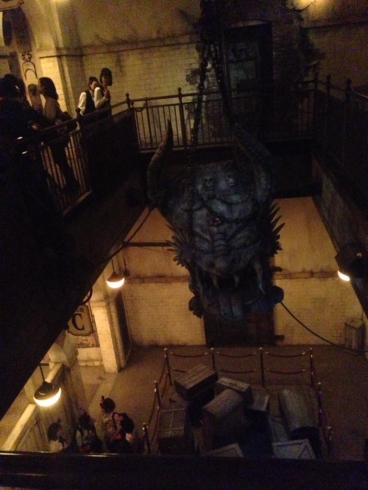 Replacing the Hollywood Tower Hotel's boiler room, the tour continues into Hightower's vault. Is it just me, or did he steal a statue of Aku from Samurai Jack?
Replacing the Hollywood Tower Hotel's boiler room, the tour continues into Hightower's vault. Is it just me, or did he steal a statue of Aku from Samurai Jack?
Of course, you’re doomed to follow him as, insisting we all must be seeing things, the tour guide continues into the two-story vault full of Renaissance paintings, Japanese statues, Egyptian treasure, and other stolen goods. There, you board an elevator to take you up to Mr. Hightower’s penthouse. Unfortunately, that’s where Shiriki is waiting. Like the other Tower of Terror rides, a freefall elevator follows, with chilling sounds and screaming, giggling Japanese people. It’s truly unbelievable.
The final area of the American Waterfront is Toyville Trolley Park. Just opened in 2012, this area only contains the Japanese version of Toy Story Mania!.
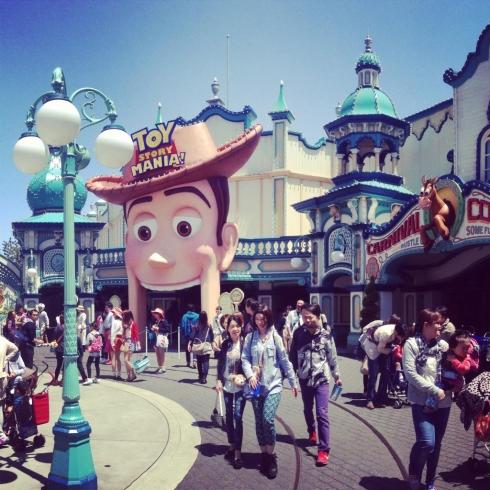
While the ride is identical to its American cousins, it’s the exterior that earned it so much praise. Again unwilling to shave a single cent off the budget, the ride is located in an East Coast midway building straight out of New York’s Coney Island (including the entrance through Woody’s open mouth, which harkens to New York’s Luna Park entry through a smiling clown’s mouth).
 Click for larger
Click for larger
The area is unbelievably beautiful, especially at night, improving on the already mouth-watering West Coast style pavilion it’s located in at California Adventure.
Port Discovery
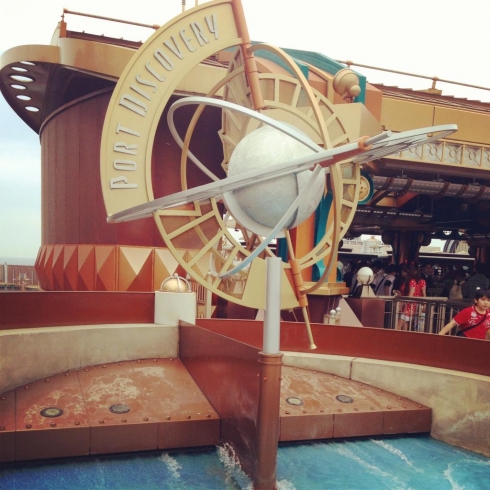 Modeled after the Discovery Bay concept originally for Disneyland in California and later realized at Disneyland Park. Doesn't this look like the Orbitron?
Modeled after the Discovery Bay concept originally for Disneyland in California and later realized at Disneyland Park. Doesn't this look like the Orbitron?
This small port is located in the back corner of the park, apparently with only a leaking dam wall separating it from the real Tokyo Bay. Stylistically, the port is reminiscent of the original plans for Disneyland’s Discovery Bay, a sort of steampunk Jules Verne retro-future of zephyrs and bubbling lagoons and glass domes. (Though Discovery Bay never materialized as a new land at Disneyland, it did become the basis of Disneyland Paris’ Tomorrowland alternative, which then in turn inspired Disneyland’s 1998 Tomorrowland renovation, which is why both of those lands should sound something like Port Discovery).
 Click for larger.
Click for larger.
Due to its limited size, Port Discovery really only contains two rides. The first is StormRider. Essentially, it’s a motion simulator similar to Star Tours, but with cabins that are literally three times larger and hold three times as many people. According to the story, the StormRider is an experimental ship designed by the Center for Weather Control (where you are – the central building of Port Discovery) equipped with a unique missile that can disappate storms. Of course, you fly into a storm and launch the missile (which is knocked back, spirals straight at you, and actually punctures the cabin in a truly startling effect). Of course, it’s all solved in the end. Disney Parks fans that make it to Tokyo often criticize the ride, perhaps for its lack of storytelling, perhaps for its lack of thrills. Indeed, the massive cabins can do little more than wobble and bounce, and the story isn’t exactly rocket science (err...?). Still, it’s a fun ride even if it could use an update.
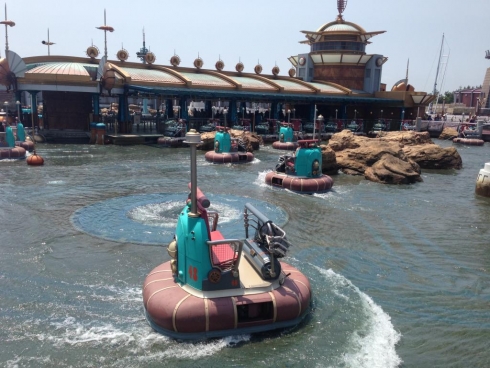
The second ride in Port Discovery is its surprise hit – Aquatopia employs the same LPS, trackless ride system as Pooh’s Hunny Hunt next door. Seated on round three-person rafts, the boats of Aquatopia exit the loading area and then separate, spinning, reversing, and accelerating through the water with no track. There are two courses – one interacts with whirlpools and jets while the other seems to dance between rockwork and pass through a cave behind a waterfall. At its core, the ride is just fun. Everyone laughs and screams as they come perilously close to waterfalls, jets, and other boats.
So that’s the eastern, bayside half of DisneySea. What are your thoughts so far? From the setting to the rides to the stories, where would DisneySea rank on your list of parks? And we’ve still got four ports to go! Let's head inland...

Add new comment